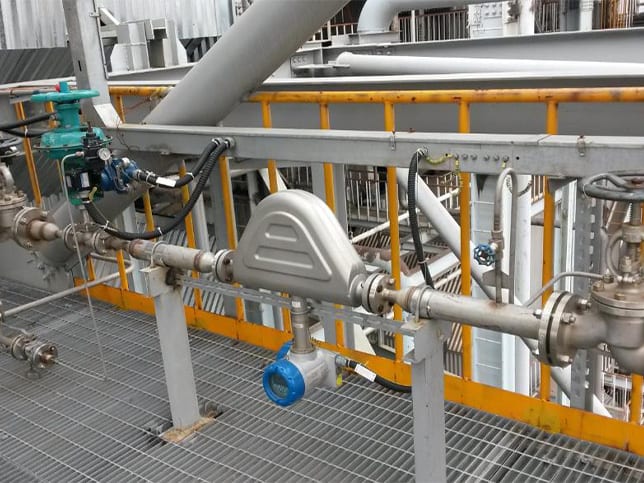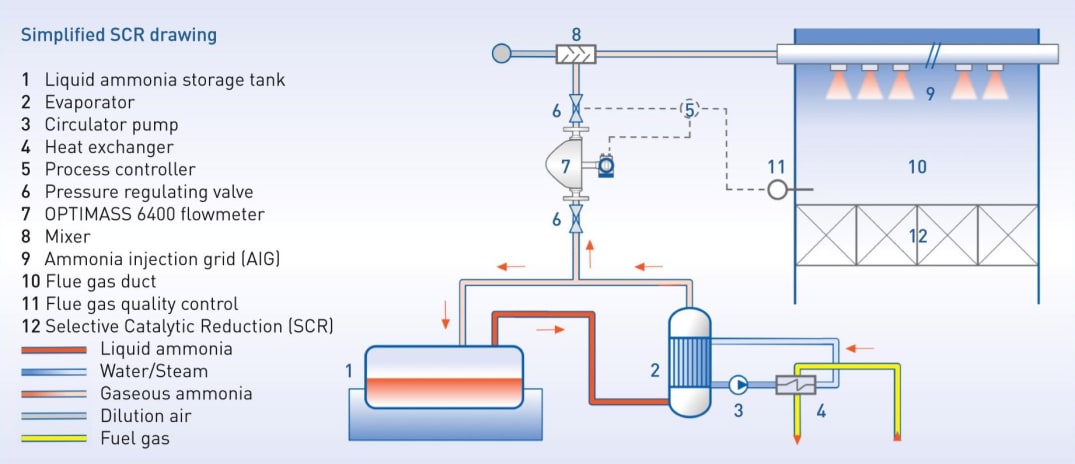Flow measurement of ammonia for NOx reduction
Application Note | Power generation
- Control of ammonia injection in the Selective Catalytic Reduction (SCR) process of a coal-fired power plant
- Precise dosing of ammonia in proportion to NOx mass flow
- Indication of condensate formation during gas flow measurement

Background
A steel producer in China operates a four-unit coal-fired power plant which supplies electricity and heat to the company’s adjacent steel plant. Rising environmental concerns and strict regulations require effective cleaning of the power plant’s flue gas. Besides limitations for substances like particulate matter, mercury and sulphur dioxide (SO2) the plant operator must meet strict restrictions in nitrogen oxide (NOx) emissions of 100 mg / m3.
Measurement requirements
To remove NOx in the post combustion process, the plant uses the Selective Catalytic Reduction (SCR). During this cleaning process, vaporized ammonia (NH3) is injected into the hot flue gas stream through an ammonia injection grid (AIG). The reductant causes the NOx to convert into nitrogen (N2) and water (H2O) while passing through the various layers of the catalyst chamber. In this way, a high catalytic conversion rate of > 90 % can be achieved.
Effective denitrification, however, requires the gaseous ammonia to be precisely dosed in proportion to the flue gas mass flow. The mass flow of produced NOx depends on many parameters like boiler load, coal type or excess air settings and thus varies over a wide range. This in turn leads to a strongly fluctuating need for ammonia to be injected. The company was therefore searching for an accurate flowmeter with a high dynamic range for ammonia dosing.
Product : Ammonia gas
Flow rate : 0…100 kg / h 9200 Nm3 / h
Temperature : 60 °C / 140 °F
Pressure : 2…3 bar / 29…43.5 psi
KROHNE Solution
The customer decided on the OPTIMASS 6400 Coriolis mass flowmeter. The KROHNE flowmeter was installed with standard flange connections (DN 25) in the feed line to the AIG. The meter is installed upside-down for this gas application to prevent the condensate collection from influencing the measurement.
The KROHNE flowmeter offers excellent accuracy in gas applications (with a measuring error of just ± 0.35 % of MV) along with high repeatability over a wide dynamic range. Featuring Entrained Gas Management (EGM™) the Coriolis flowmeter even detects condensate formation in the ammonia pipe. Due to its advanced digital signal processing, the Coriolis mass flowmeter is also able to give an indication whether the ammonia evaporation process is always stable.
Customer benefits
The OPTIMASS 6400 contributes significantly to the plant’s denitrification rate. The injection of ammonia can be precisely controlled in proportion to the NOx mass flow. Over-injection and the subsequent release of unreacted ammonia (“ammonia slip”) are prevented. The plant operator thus benefits from effective denitrification at the best possible ammonia production yield.
The EGM™ functionality of the flowmeter turned out to be of additional benefit to the customer’s process control. The OPTIMASS 6400 indicates the presence of condensate in the geaseous ammonia stream, which supplies additional process information and indicates the proper function of the evaporator located upstream. Thus, using the flowmeter helps the customer improve process safety.




